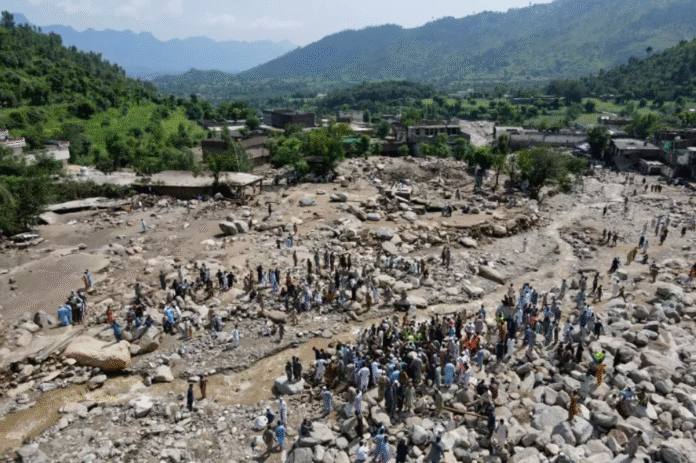Pakistan Floods and Cloudbursts: Deadly Monsoon Leaves 360 Dead in 2025
Pakistan floods and cloudbursts have once again highlighted the country’s vulnerability to extreme weather. This year’s monsoon season has been particularly devastating, killing more than 360 people in Pakistan and Pakistan-administered Kashmir within days.
The northern districts of Khyber Pakhtunkhwa province have been the hardest hit, with entire villages swallowed by raging rivers, landslides, and collapsing houses. Officials warn that the crisis is far from over, as more rainfall and landslides remain a threat.
Rising Death Toll Across Pakistan
Since Friday, floods triggered by torrential rains have claimed at least 360 lives, with more than 100 people still missing. The destruction is most severe in the northwestern province of Khyber Pakhtunkhwa, where swollen rivers and mudslides buried families beneath debris.
Authorities have urged local administrations to remain on high alert, warning that further Pakistan floods and cloudbursts could devastate additional communities.
Buner District: The Epicenter of Tragedy
Buner district, located about 100km from Islamabad, has suffered unimaginable loss. At least 207 people were killed in just two days as landslides and floods swept through villages.
Satellite images show the once-thriving district blanketed with mud, debris, and collapsed homes. Pir Baba town and nearby villages are now unrecognizable, buried under layers of sludge and broken structures.
Rescue workers are still searching for bodies under the wreckage. Survivors recount scenes of chaos as torrents of water carried boulders down mountainsides, smashing into homes “like explosions.”
What Exactly is a Cloudburst?
A key factor behind the devastation in Buner was a cloudburst, a rare weather event in which more than 100mm of rain falls in under an hour within a small area. In Buner, over 150mm of rainfall was recorded in just 60 minutes.
Cloudbursts are particularly destructive in mountainous areas because steep slopes accelerate water flow, causing landslides and flash floods. These sudden downpours often come with thunder, lightning, and hail, overwhelming communities without warning.

Voices From the Ground
Aziz Ahmed, a teacher from Buner, described the storm as apocalyptic.
“The thunder was so loud that I thought the end of the world had come,” he said.
His words echo the trauma felt by countless families. Some survivors reported losing multiple relatives in minutes, while others said the psychological toll of the tragedy is unbearable.
Monsoon Patterns Intensify
Pakistan’s monsoon rains typically run from July to September, with peak rainfall in August. But this year, the rains have been far more intense.
Since June, nearly 650 people have died and close to 1,000 have been injured across Pakistan due to floods and landslides. Lieutenant General Inam Haider Malik, Chairman of the National Disaster Management Authority, said rainfall this year is 50 to 60 percent stronger than in 2024.
The hardest-hit province remains Khyber Pakhtunkhwa, with 425 deaths, followed by Punjab with 164 fatalities. Thousands of homes have been damaged or destroyed, leaving families without shelter.
Housing and Infrastructure Losses
The scale of destruction is staggering:
-
2,707 homes damaged nationwide
-
941 homes destroyed in Khyber Pakhtunkhwa
-
719 homes damaged in Azad Jammu and Kashmir
These figures highlight the vulnerability of Pakistan’s infrastructure to extreme weather. Mud-built houses, common in rural areas, stand little chance against the force of flash floods and collapsing mountainsides.

Gaps in Early Warning Systems
Many residents in Buner accuse local officials of failing to provide timely warnings. Traditionally, mosque loudspeakers alert villagers to disasters, but survivors said no warnings were given before the sudden cloudburst.
The government acknowledged that while an early warning system exists, the intensity of the rain meant the deluge struck before alerts could reach communities. This failure raises urgent questions about the effectiveness of Pakistan’s disaster preparedness.
Pakistan’s Climate Vulnerability
Pakistan is among the top 10 most climate-vulnerable countries in the world, despite contributing less than 1% of global greenhouse gas emissions. The country faces recurring heatwaves, glacial lake outburst floods, flash floods, and cloudbursts, which have intensified due to climate change.
In 2022, Pakistan experienced its worst floods on record, killing over 1,700 people and causing $40 billion in damage. The 2025 floods echo the same challenges, underscoring the urgent need for stronger infrastructure, early warning systems, and global climate cooperation.

Lessons From History
Disasters like these are not new. In 2010, catastrophic floods killed 1,700 people and affected 20 million. Once again, Pakistan is facing the same struggle: how to balance recovery with long-term adaptation in the face of worsening monsoons.
The message is clear without global and local action, tragedies caused by Pakistan floods and cloudbursts will continue to repeat.
Conclusion
The 2025 monsoon has already killed hundreds and displaced thousands, and experts warn the worst may not yet be over. For families in Buner and other affected areas, survival now depends on rescue efforts, international aid, and stronger climate resilience.
The story of Pakistan floods and cloudbursts is not just about weather, it is about lives lost, homes destroyed, and the urgent call for climate action.

